
|
acetic acid |
acetic acid is a lipid of Fatty Acyls (FA) class. Acetic acid is associated with abnormalities such as Vitamin B 12 Deficiency. The involved functions are known as Excretory function. The related lipids are Propionate. |
89633 |

|
Arachidonic acid |
Arachidonic acid is a lipid of Fatty Acyls (FA) class. Arachidonic acid is associated with abnormalities such as Atherosclerosis, Ischemia, Hypertensive disease, Hypertension induced by pregnancy and Vascular ring of aorta. The involved functions are known as Platelet aggregation, Anabolism, Ion Transport, Signal Transduction Pathways and Signal. Arachidonic acid often locates in Extracellular, Body tissue, Protoplasm, Tissue membrane and soluble. The associated genes with Arachidonic acid are CYP2J2 gene, CYP2E1 gene, Recombinant Proteins, POR gene and P4HTM gene. The related lipids are Fatty Acids, Glycerophospholipids, Steroids, octadecadienoic acid and 9-hydroxy-10,12-octadecadienoic acid. The related experimental models are Mouse Model and Knock-out. |
22864 |

|
Anandamide |
Anandamide is a lipid of Fatty Acyls (FA) class. Anandamide is associated with abnormalities such as Dehydration. The involved functions are known as Process, Phenomenon, Phosphorylation, Catabolic Process and Gene Expression. Anandamide often locates in Nuchal region, Microglial and Hepatic. The associated genes with Anandamide are SGPL1 gene, SPTLC1 gene, RPSA gene, KDSR gene and SMPD1 gene. The related lipids are Sphingolipids, Lipopolysaccharides, Lysophospholipids, LYSO-PC and lysophosphatidylethanolamine. |
4747 |
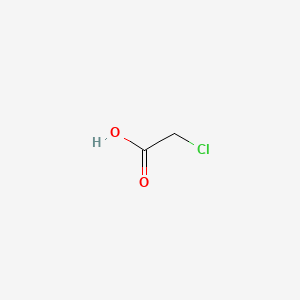
|
2-chloro-acetic acid |
2-chloro-acetic acid is a lipid of Fatty Acyls (FA) class. |
574 |

|
4-aminobutyric acid |
4-aminobutyric acid is a lipid of Fatty Acyls (FA) class. 4-aminobutyric acid is associated with abnormalities such as Epilepsy and Premenstrual syndrome. The involved functions are known as Binding (Molecular Function), neuron survival, Process, Uptake and physiological aspects. 4-aminobutyric acid often locates in Microglial, Neurofilament, Neuraxis, Brain region and Neurites. The associated genes with 4-aminobutyric acid are arginine methyl ester, SLC33A1 gene, NKS1 gene, P4HTM gene and ITSN2 gene. The related lipids are pregnenolone sulfate, pregnane-20-one, Pregnanes, Steroids and endogenous steroids. |
19702 |

|
Lipoic acid |
Lipoic acid is a lipid of Fatty Acyls (FA) class. |
7940 |

|
PGD2 |
Pgd2 is a lipid of Fatty Acyls (FA) class. Pgd2 is associated with abnormalities such as Inflammatory disorder, Pleurisy, Rhinitis, Dehydration and Pneumonia. The involved functions are known as antagonists, fat cell differentiation, Phosphorylation, Process and Gene Expression. Pgd2 often locates in Cell surface, Body tissue, Extracellular, Bone Marrow and Membrane. The associated genes with PGD2 are oxytocin, 1-desamino-(O-Et-Tyr)(2)-, P4HTM gene, PTGS2 gene, PTGDS gene and IL3 gene. The related lipids are 15-deoxyprostaglandin J2, Nonesterified Fatty Acids, Lipopolysaccharides, Steroids and Liposomes. The related experimental models are Knock-out and Rodent Model. |
6464 |
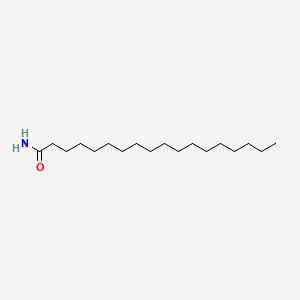
|
Octadecanamide |
Octadecanamide is a lipid of Fatty Acyls (FA) class. |
24 |
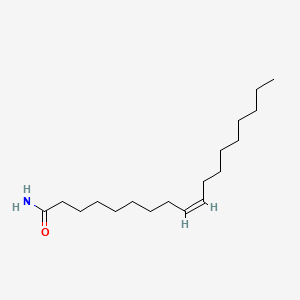
|
Oleamide |
Oleamide is a lipid of Fatty Acyls (FA) class. Oleamide is associated with abnormalities such as Blepharoptosis, BOSLEY-SALIH-ALORAINY SYNDROME, abnormal fragmented structure, Syndrome and Hashimoto Disease. The involved functions are known as Anabolism, Regulation, receptor ligand, Process and Binding (Molecular Function). Oleamide often locates in receptor complex, Tissue membrane, Membrane, annulus and Connexon. The associated genes with Oleamide are Homologous Gene, FAAH gene, FAAH2 gene, P4HTM gene and Integral Membrane Proteins. The related lipids are Fatty Acids, Membrane Lipids, N-acylethanolamines, erucyl amide and linoleamide. |
349 |
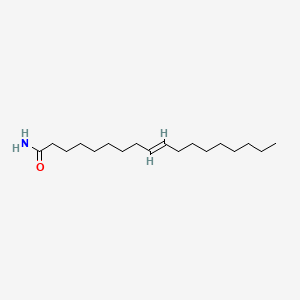
|
Elaidamide |
Elaidamide is a lipid of Fatty Acyls (FA) class. Elaidamide is associated with abnormalities such as Wiskott-Aldrich Syndrome. The involved functions are known as inhibitors, salivary gland development and branching morphogenesis. |
204 |
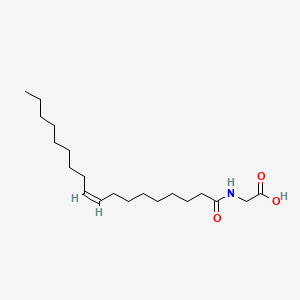
|
N-oleoyl glycine |
N-oleoyl glycine is a lipid of Fatty Acyls (FA) class. |
9 |
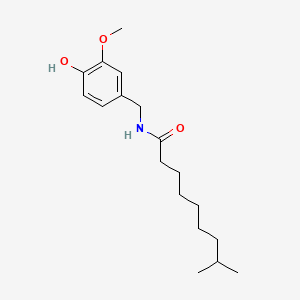
|
Capsaicin |
Capsaicin is a lipid of Fatty Acyls (FA) class. Capsaicin is associated with abnormalities such as Morphologically altered structure. The involved functions are known as inhibitors, Regulation, metaplastic cell transformation, Biochemical Pathway and Uptake. Capsaicin often locates in Tissue fiber, Mucous Membrane, Nerve Endings, group Ia axon and Membrane. The associated genes with Capsaicin are TRPV1 gene, WT-1, MAP1LC3A gene, EIF2S3 gene and SLC33A1 gene. The related experimental models are Transgenic Model. |
235 |
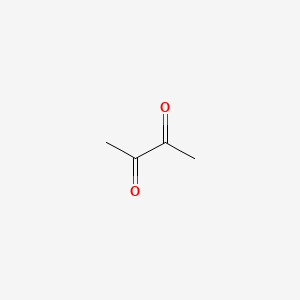
|
2,3-butanedione |
2,3-butanedione is a lipid of Fatty Acyls (FA) class. The involved functions are known as Physiologic Organization, Biochemical Pathway, physiological aspects, establishment and maintenance of localization and Phosphorylation. 2,3-butanedione often locates in Membrane, Microfilaments, Microtubules, Cell body of neuron and filamentous actin location. The associated genes with 2,3-butanedione are SLC33A1 gene and WASF1 gene. |
2715 |
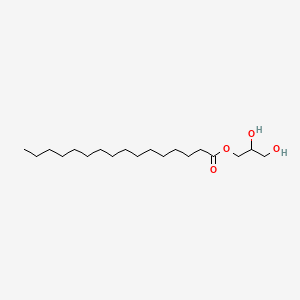
|
1-Palmitoyl-rac-glycerol |
1-Palmitoyl-rac-glycerol is a lipid of Glycerolipids (GL) class. 1-palmitoyl-rac-glycerol is associated with abnormalities such as Eczema, Food Allergy and Fatty Liver. The involved functions are known as inhibitors, lysophospholipase activity, Adjudication, cell transformation and Detergents. 1-palmitoyl-rac-glycerol often locates in Cytosol and soluble fraction. The associated genes with 1-Palmitoyl-rac-glycerol are FASTK Gene. The related lipids are 1,2-oleoylphosphatidylcholine, Lysophospholipids, phenyl valerate, Lysophosphatidylcholines and Palmitates. |
197 |
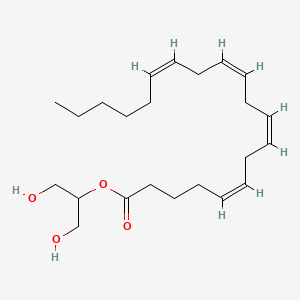
|
2-arachidonoylglycerol |
2-arachidonoylglycerol is a lipid of Glycerolipids (GL) class. 2-arachidonoylglycerol is associated with abnormalities such as Atherosclerosis, Heart Diseases, Inflammatory disorder, Colitis and Peripheral Neuropathy. The involved functions are known as Immunoreactivity, inhibitors, Stimulus, Esthesia and Signal Transduction. 2-arachidonoylglycerol often locates in Back, Presynaptic Terminals, Brain region, Blood and Body tissue. The associated genes with 2-arachidonoylglycerol are ADRBK1 gene, Homologous Gene, MGLL gene, PLA2G4A gene and peptide V. The related lipids are oleoylethanolamide, Lipopolysaccharides, Promega, stearic acid and 1-stearoyl-2-arachidonoylglycerol. The related experimental models are Knock-out. |
1892 |
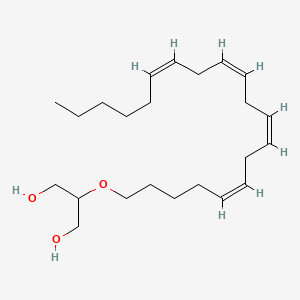
|
noladin ether |
Noladin ether is a lipid of Glycerolipids (GL) class. The involved functions are known as 5-(carboxyamino)imidazole ribonucleotide mutase activity and Competitive inhibition. Noladin ether often locates in Synaptosomes and Tissue membrane. The associated genes with Noladin Ether are IMPACT gene. The related lipids are noladin ether and Fatty Alcohols. |
72 |

|
tacrolimus |
Tacrolimus is a lipid of Polyketides (PK) class. Tacrolimus is associated with abnormalities such as Renal glomerular disease. The involved functions are known as inhibitors, Fungicidal activity, Metabolic Inhibition, Excretory function and Dephosphorylation. Tacrolimus often locates in Hepatic, Mitochondrial matrix and Inner mitochondrial membrane. The associated genes with Tacrolimus are RHOA gene and BGN gene. |
12730 |

|
erythromycin |
erythromycin is a lipid of Polyketides (PK) class. Erythromycin is associated with abnormalities such as Systemic Inflammatory Response Syndrome, Pneumonia, Infection, Pneumococcal Infections and Exanthema. The involved functions are known as Pharmacodynamics, Sterility, Agent, Drug Kinetics and Adjudication. Erythromycin often locates in Blood, peritoneal, Extracellular, Ribosomes and apicoplast. The associated genes with erythromycin are P4HTM gene, SLC33A1 gene, FAM3B gene, Operon and Homologous Gene. The related lipids are Hydroxytestosterones, Steroids, Propionate, Mycolic Acids and campesterol. The related experimental models are Mouse Model and Knock-out. |
19871 |

|
forskolin |
Forskolin is a lipid of Prenol Lipids (PR) class. Forskolin is associated with abnormalities such as Cholestasis, Vocal cord dysfunction familial, Hypothyroidism, Renal tubular disorder and Disintegration (morphologic abnormality). The involved functions are known as Cell Proliferation, Anabolism, mRNA Expression, Agent and Signal. Forskolin often locates in Extracellular, Body tissue, Skin, Tissue membrane and Membrane. The associated genes with forskolin are P4HTM gene, SLC33A1 gene, NR1I2 gene, Genes, Reporter and CYP3A gene. The related lipids are Steroids, steroid sulfate, Fatty Acids, LYSO-PC and Lipopolysaccharides. |
24755 |


















